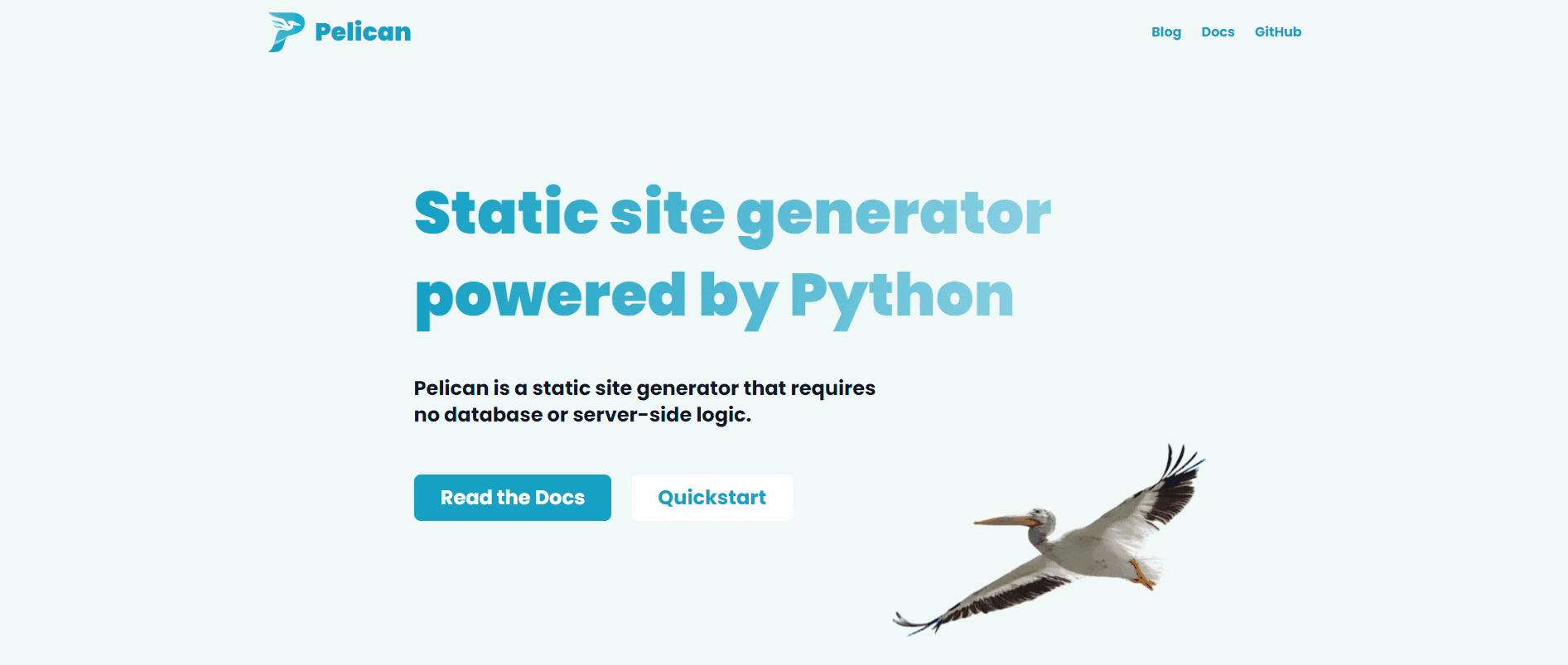Make pelican blog
1. What is Pelican?

Pelican is Static site generator powered by Python
“Pelican” is an anagram of calepin, which means “notebook” in French.
you can see more information at Pelican Offical Site.
2. Pelican Quick Start
2.1 Install Dependencies
💡 Prerequisites
Pelican should be presupposed cause it is python based. confirm below commands
pythonpip
# core library
pip install pelican
# additional library: markdown
# add markdown package for using markdown editor
pip install markdown
# additional library: typogrify
# add typogrify for typographically-improved HTML
pip install typogrify
2.2 Create Project
write below commands sequentially
# make folder for project
mkdir pelican-demo
# move to folder
cd pelican-demo
# initialize folder for Pelican project
pelican-quickstart
you can configure options while running command
Welcome to pelican-quickstart v4.9.1.
This script will help you create a new Pelican-based website.
Please answer the following questions so this script can generate the files
needed by Pelican.
> Where do you want to create your new web site? [.]
> What will be the title of this web site? Pelican Demo
> Who will be the author of this web site? Heejeong Kim
> What will be the default language of this web site? [Korean]
> Do you want to specify a URL prefix? e.g., https://example.com (Y/n) n
> Do you want to enable article pagination? (Y/n) y
> How many articles per page do you want? [10]
> What is your time zone? [Europe/Rome]
> Do you want to generate a tasks.py/Makefile to automate generation and publishing? (Y/n) y
> Do you want to upload your website using FTP? (y/N) n
> Do you want to upload your website using SSH? (y/N) n
> Do you want to upload your website using Dropbox? (y/N) n
> Do you want to upload your website using S3? (y/N) n
> Do you want to upload your website using Rackspace Cloud Files? (y/N) n
> Do you want to upload your website using GitHub Pages? (y/N) y
> Is this your personal page (username.github.io)? (y/N) n
2.3 Structure
The project has below structure if you make project via pelican-quickstart.
yourproject/
├── content # posting directory
│ └── (pages)
├── output # build directory
├── tasks.py # setting and running code
├── Makefile # build file
├── pelicanconf.py # Main Setting file
└── publishconf.py # Settings to use when ready to publish
you make a new .md file in content directory if you want to write a new post
2.4 Command
build ⚡
you can run project after build
# default command
pelican
# command with [path]
pelican content
# command with [path] [-o output_directory] [-s setting_file] [-t template_directory]
pelican content -o output -s publishconf.py -t themes/twinkle
run 🔥
pelican --listen
etc
if you want to see more, type pelican --help
pelican --help
usage: pelican [-h] [-t THEME] [-o OUTPUT] [-s SETTINGS] [-d] [-v] [-q] [-D] [--version] [-r]
[--print-settings [SETTING_NAME ...]] [--relative-urls] [--cache-path CACHE_PATH] [--ignore-cache]
[--fatal errors|warnings] [--logs-dedup-min-level {DEBUG,INFO,WARNING,ERROR}] [-l] [-p PORT] [-b BIND]
[-e [OVERRIDES ...]]
[path]
A tool to generate a static blog, with restructured text input files.
positional arguments:
path Path where to find the content files. (default: None)
options:
-h, --help show this help message and exit
-t THEME, --theme-path THEME
Path where to find the theme templates. If not specified, it will use the default one included
with pelican. (default: None)
-o OUTPUT, --output OUTPUT
Where to output the generated files. If not specified, a directory will be created, named
"output" in the current path. (default: None)
-s SETTINGS, --settings SETTINGS
The settings of the application, this is automatically set to pelicanconf.py if a file exists
with this name. (default: None)
-d, --delete-output-directory
Delete the output directory. (default: None)
-v, --verbose Show all messages. (default: None)
-q, --quiet Show only critical errors. (default: None)
-D, --debug Show all messages, including debug messages. (default: None)
--version Print the pelican version and exit.
-r, --autoreload Relaunch pelican each time a modification occurs on the content files. (default: False)
--print-settings [SETTING_NAME ...]
Print current configuration settings and exit. Append one or more setting name arguments to
see the values for specific settings only. (default: None)
--relative-urls Use relative urls in output, useful for site development (default: False)
--cache-path CACHE_PATH
Directory in which to store cache files. If not specified, defaults to "cache". (default:
None)
--ignore-cache Ignore content cache from previous runs by not loading cache files. (default: False)
--fatal errors|warnings
Exit the program with non-zero status if any errors/warnings encountered. (default: )
--logs-dedup-min-level {DEBUG,INFO,WARNING,ERROR}
Only enable log de-duplication for levels equal to or above the specified value (default:
WARNING)
-l, --listen Serve content files via HTTP and port 8000. (default: False)
-p PORT, --port PORT Port to serve HTTP files at. (default: 8000) (default: None)
-b BIND, --bind BIND IP to bind to when serving files via HTTP (default: 127.0.0.1) (default: None)
-e [OVERRIDES ...], --extra-settings [OVERRIDES ...]
Specify one or more SETTING=VALUE pairs to override settings. VALUE must be in JSON notation:
specify string values as SETTING='"some string"'; booleans as SETTING=true or SETTING=false;
None as SETTING=null. (default: {})
Comments